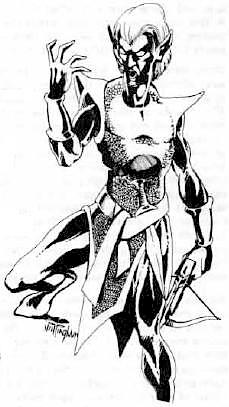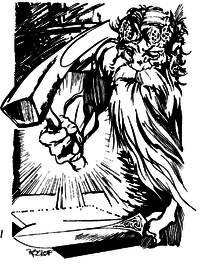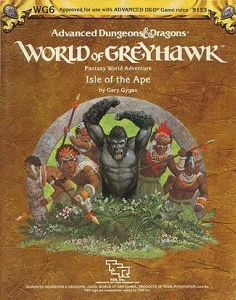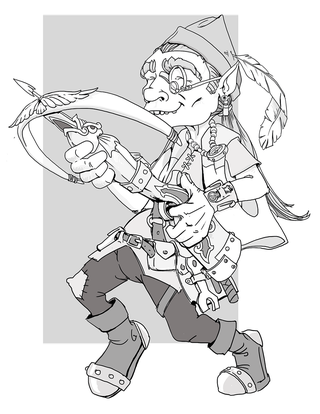
Mystara is a campaign setting for the Dungeons & Dragons fantasy role playing game. It was the default setting for the "Basic" version of the game throughout the 1980s and 1990s. Most adventures published for the "Basic" edition of D&D take place in "The Known World", a central continent that includes a varied patchwork of both human and non-human realms. The human realms are based on various real-world historical cultures. In addition, unlike other D&D settings, Mystara had ascended immortal beings instead of gods.

The drow or dark elves are a dark-skinned and white-haired subrace of elves connected to the subterranean Underdark in the Dungeons & Dragons fantasy roleplaying game. The drow have traditionally been portrayed as generally evil and connected to the evil spider goddess Lolth. However, later editions of Dungeons & Dragons have moved away from this portrayal and preassigned alignment. More recent publications have explored drow societies unconnected to Lolth.
Faerûn is a fictional continent and the primary setting of the Dungeons & Dragons world of Forgotten Realms. It is described in detail in several editions of the Forgotten Realms Campaign Setting with the most recent being the 5th edition from Wizards of the Coast, and various locales and aspects are described in more depth in separate campaign setting books. Around a hundred novels, several computer and video games and a film use Faerûn as the setting.
In the fantasy role-playing game Dungeons & Dragons, an Outer Plane is one of a number of general types of planes of existence. They can also be referred to as godly planes, spiritual planes, or divine planes. The Outer Planes are home to beings such as deities and their servants such as demons, celestials and devils. Each Outer Plane is usually the physical manifestation of a particular moral and ethical alignment and the entities that dwell there often embody the traits related to that alignment.
The Underdark is a fictional setting which has appeared in Dungeons & Dragons role-playing campaigns and Dungeons & Dragons-based fiction books, including the Legend of Drizzt series by R. A. Salvatore. It is described as a vast subterranean network of interconnected caverns and tunnels, stretching beneath entire continents and forming an underworld for surface settings. Polygon called it "one of D&D's most well-known realms".
Several different editions of the Dungeons & Dragons (D&D) fantasy role-playing game have been produced since 1974. The current publisher of D&D, Wizards of the Coast, produces new materials only for the most current edition of the game. However, many D&D fans continue to play older versions of the game and some third-party companies continue to publish materials compatible with these older editions.

Moradin is the chief deity in the dwarven pantheon in the Dungeons & Dragons game and is a member of the default D&D pantheon. In 3rd edition, Moradin's domains are Creation, Earth, Good, Law, and Protection. The 5th Edition Players Handbook include Knowledge as a suggested domain. His titles include Soul Forger, Dwarffather, the All-Father, and the Creator. He created the first dwarves out of earthen materials and tutored them in dwarven ways.

Mordenkainen is a fictional wizard from the World of Greyhawk campaign setting for the Dungeons & Dragons roleplaying game. He was created by Gary Gygax as a player character, only months after the start of Gygax's Greyhawk campaign and is therefore one of the oldest characters continuously associated with Dungeons & Dragons.
The flexibility of the Dungeons & Dragons (D&D) game rules means that Dungeon Masters (DM) are free to create their own fantasy campaign settings. For those who wanted a pre-packaged setting in which to play, TSR, Wizards of the Coast (WotC), and other publishers have created many settings in which D&D games can be based; of these, the Forgotten Realms, an epic fantasy world, has been one of the most successful and critically acclaimed settings. Many campaign settings include standard sword and sorcery environments, while others borrow Asian, Central American, swashbuckling, horror and even space-travel themes.

Isle of the Ape is an adventure module for the Dungeons & Dragons role-playing game World of Greyhawk campaign setting, in which the events occur in a magical demiplane of the same name created by the mad archmage Zagyg Yragerne.

The elf is a humanoid race in the Dungeons & Dragons fantasy role-playing game, one of the primary races available for player characters, and play a central role in the narratives of many setting worlds of the game. Elves are described as renowned for their grace and mastery of magic and weapons such as the bow and sword. Becoming physically mature by the age of 25 and emotionally mature at around 125, they are also famously long-lived, capable of living more than half a millennium and remaining physically youthful. Possessed of innate beauty and easy gracefulness, they are viewed as both wondrous and haughty by other races in-universe; however, their natural detachment is seen by some as introversion or xenophobia. They were usually portrayed as antagonistic towards dwarves.

In the Dungeons & Dragons role-playing game, orcs are a primitive race of savage, bestial, barbaric humanoid.

Kobolds are a fictional race of humanoid creatures, featured in the Dungeons & Dragons roleplaying game and other fantasy media. They are generally depicted as small reptilian humanoids with long tails, distantly related to dragons.

In the Dungeons & Dragons fantasy role-playing game, goblins are a common and fairly weak race of evil humanoid monsters. Goblins are non-human monsters that low-level player characters often face in combat.

In the Dungeons & Dragons fantasy role-playing game, the centaur is a large monstrous humanoid. Based upon the centaurs of Greek myth, a centaur in the game resembles a human with the lower body of a horse.

In the Dungeons & Dragons fantasy role-playing game, giants are a collection of very large humanoid creatures based on giants of legend, or in third edition, a "creature type".

Dwellers of the Forbidden City is an adventure module, or pre-packaged adventure booklet, ready for use by Dungeon Masters in the Dungeons & Dragons (D&D) fantasy role-playing game. The adventure was first used as a module for tournament play at the 1980 Origins Game Fair, and was later published by TSR in 1981 for use with the first edition Advanced Dungeons & Dragons rules. The module was written by game designer David "Zeb" Cook, who partly ascribes his hiring by TSR to his work on this module. In the adventure, the characters are hired to recover a stolen object from a hidden oriental-style city ruled by a snake-worshipping cult of yuan-ti and their mongrelmen and tasloi servants.
The half-elf is a player character race featured in Dungeons & Dragons and related material.

The Complete Book of Dwarves is a supplemental rulebook for the 2nd edition of the Advanced Dungeons & Dragons fantasy role-playing game, published in 1991 by TSR, Inc. It contains a variety of information useful to playing dwarf characters in the game, including information on strongholds, dwarven subraces, character "kits", role-playing, mining, and more. The book was later reprinted in November 1993, with a slightly different cover.

In the Dungeons & Dragons fantasy role-playing game, gnomes are one of the core races available for play as player characters. Some speculate that they are closely related to dwarves; however, gnomes are smaller and more tolerant of other races, nature, and magic. Depending on the setting and subrace, they are often skilled with illusion magic or engineering. Gnomes are small humanoids, standing 3–3.5 feet (91–107 cm) tall.













